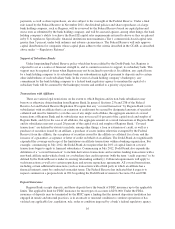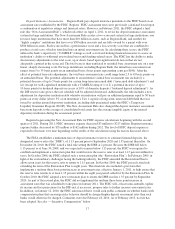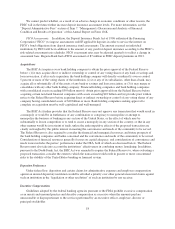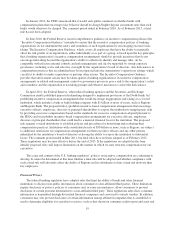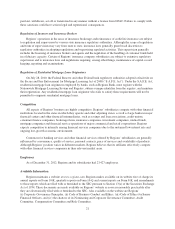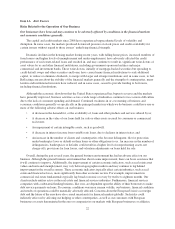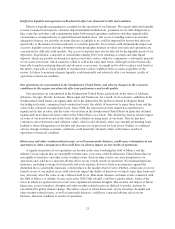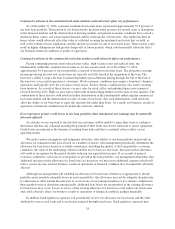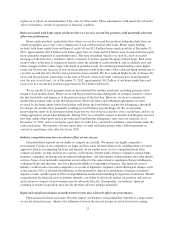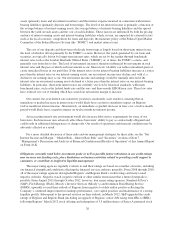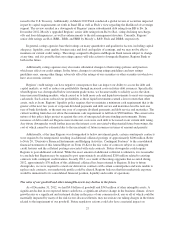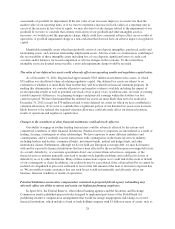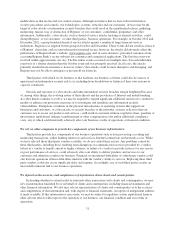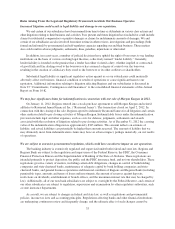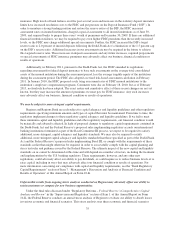Regions Bank 2012 Annual Report Download - page 41
Download and view the complete annual report
Please find page 41 of the 2012 Regions Bank annual report below. You can navigate through the pages in the report by either clicking on the pages listed below, or by using the keyword search tool below to find specific information within the annual report.require us to adjust our determination of the value for these items. These adjustments could materially adversely
affect our business, results of operations or financial condition.
Risks associated with home equity products where we are in a second lien position could materially adversely
affect our performance.
Home equity products, particularly those where we are in a second lien position, and particularly those in
certain geographic areas, may carry a higher risk of non-collection than other loans. Home equity lending
includes both home equity loans and lines of credit. Of our $11.8 billion home equity portfolio at December 31,
2012, approximately $10.4 billion were home equity lines of credit and $1.4 billion were closed-end home equity
loans (primarily originated as amortizing loans). This type of lending, which is secured by a first or second
mortgage on the borrower’s residence, allows customers to borrow against the equity in their home. Real estate
market values at the time of origination directly affect the amount of credit extended, and, in addition, past and
future changes in these values impact the depth of potential losses. Second lien position lending carries higher
credit risk because any decrease in real estate pricing may result in the value of the collateral being insufficient to
cover the second lien after the first lien position has been satisfied. We have realized higher levels of charge-offs
on second lien positions, particularly in the state of Florida, where real estate valuations have been depressed
over the past several years. As of December 31, 2012, approximately $6.2 billion of our home equity lines and
loans were in a second lien position (approximately $2.4 billion in Florida).
We are unable to track payment status on first liens held by another institution, including payment status
related to loan modifications. When our second lien position becomes delinquent, an attempt is made to contact
the first lien holder and inquire as to the payment status of the first lien. However, we do not continuously
monitor the payment status of the first lien position. Short sale offers and settlement agreements are often
received by the home equity junior lien holders well before the loan balance reaches the delinquency threshold
for charge-off consideration, potentially resulting in a full balance payoff/charge-off. We are presently
monitoring the status of all first lien position loans that we own or service and also own a second lien, and we are
taking appropriate action when delinquent. During 2012, we evaluated a means to monitor non-Regions-serviced
first liens using a third-party service provider and found that the delinquency rates were not material. As of
December 31, 2012, none of our home equity lines of credit have converted to mandatory amortization under the
contractual terms. The majority of home equity lines of credit will either mature with a balloon payment or
convert to amortizing status after fiscal year 2020.
Industry competition may have an adverse effect on our success.
Our profitability depends on our ability to compete successfully. We operate in a highly competitive
environment. Certain of our competitors are larger and have more resources than we do, enabling them to be more
aggressive than us in competing for loans and deposits. In our market areas, we face competition from other
commercial banks, savings and loan associations, credit unions, Internet banks, finance companies, mutual funds,
insurance companies, brokerage and investment banking firms, and other financial intermediaries that offer similar
services. Some of our non-bank competitors are not subject to the same extensive regulations that govern Regions
or Regions Bank and, therefore, may have greater flexibility in competing for business. The financial services
industry could become even more competitive as a result of legislative, regulatory and technological changes, such
as the repeal in 2011 of all federal prohibitions on the payment by depository institutions of interest on demand
deposit accounts and the repeal in 2010 of all prohibitions on interstate branching by depository institutions. Should
competition in the financial services industry intensify, our ability to effectively market our products and services
and to retain or compete for new business may be adversely affected. Consequently, our business, financial
condition or results of operations may also be adversely affected, perhaps materially.
Rapid and significant changes in market interest rates may adversely affect our performance.
Fluctuations in interest rates may adversely impact our business. Our profitability depends to a large extent
on our net interest income, which is the difference between the interest income received on interest-earning
25



